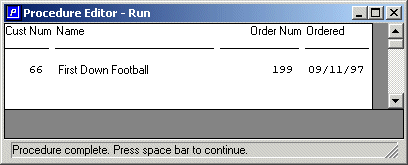|
FOR EACH Customer NO-LOCK WHERE Customer.State = "NH" WITH FRAME f:
DISPLAY Customer.CustNum Customer.Name. OrderBlock: FOR EACH Order OF Customer NO-LOCK BY Order.OrderDate: DISPLAY Order.OrderNum Order.OrderDate WITH FRAME f. LEAVE OrderBlock. END. /* FOR EACH Order */ END. /* FOR EACH Customer */ |
|
CustBlock:
FOR EACH Customer NO-LOCK WHERE Customer.State = "NH" WITH FRAME f: DISPLAY Customer.CustNum Customer.Name. OrderBlock: FOR EACH Order OF Customer NO-LOCK BY Order.OrderDate: DISPLAY Order.OrderNum Order.OrderDate WITH FRAME f. LEAVE CustBlock. END. /* FOR EACH Order */ END. /* FOR EACH Customer */ |
